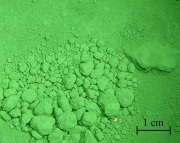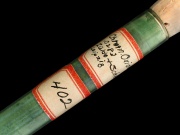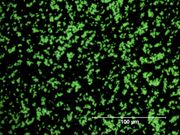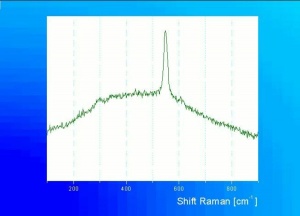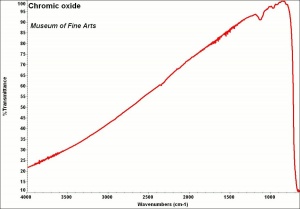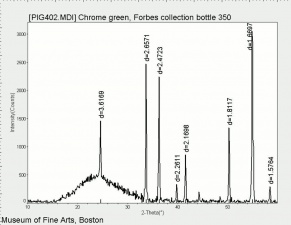Difference between revisions of "Chromic oxide"
| (One intermediate revision by the same user not shown) | |||
| Line 5: | Line 5: | ||
[[File:402 chromic oxide.jpg|thumb|Chromic oxide]] | [[File:402 chromic oxide.jpg|thumb|Chromic oxide]] | ||
| + | [[File:35_Chrom_oxide_green_500X.jpg|thumb|Chromium oxide green]] | ||
== Synonyms and Related Terms == | == Synonyms and Related Terms == | ||
| Line 10: | Line 11: | ||
[[[SliderGallery rightalign|chromeoxideopaque531.jpg~Raman|Chromium oxide green, opaque, Forbes 64.jpg~FTIR|Chromicoxide5m.jpg~FTIR|Chromicoxide5m.jpg~FTIR|PIG402.jpg~XRD]]] | [[[SliderGallery rightalign|chromeoxideopaque531.jpg~Raman|Chromium oxide green, opaque, Forbes 64.jpg~FTIR|Chromicoxide5m.jpg~FTIR|Chromicoxide5m.jpg~FTIR|PIG402.jpg~XRD]]] | ||
| + | == Risks == | ||
| − | == | + | * Toxic by ingestion, inhalation and skin contact. |
| + | * Suspected carcinogen. | ||
| + | * Non-flammable | ||
| + | * ThermoFisher: [https://www.fishersci.com/store/msds?partNumber=C334500&productDescription=CHROMIC+OXIDE+SESQUI+CERT+500G&vendorId=VN00033897&countryCode=US&language=en SDS] | ||
| + | == Physical and Chemical Properties == | ||
| − | Particle size 0.1 - 1.0 micrometers. Anisotropic. | + | * Particle size 0.1 - 1.0 micrometers. |
| − | + | * Anisotropic. | |
| − | Resistant to acids and alkalis. Hexagonal crystal system. | + | * Resistant to acids and alkalis. |
| − | + | * Hexagonal crystal system. | |
| − | Pleochroism from emerald to olive green. | + | * Pleochroism from emerald to olive green. |
{| class="wikitable" | {| class="wikitable" | ||
| Line 28: | Line 34: | ||
|- | |- | ||
! scope="row"| Melting Point | ! scope="row"| Melting Point | ||
| − | | 2241-2291 | + | | 2241-2291 C |
|- | |- | ||
! scope="row"| Density | ! scope="row"| Density | ||
| − | | 5.10-5.21 | + | | 5.10-5.21 g/ml |
|- | |- | ||
! scope="row"| Molecular Weight | ! scope="row"| Molecular Weight | ||
| Line 40: | Line 46: | ||
|- | |- | ||
! scope="row"| Boiling Point | ! scope="row"| Boiling Point | ||
| − | | 4000 | + | | 4000 C |
|} | |} | ||
| − | |||
| − | |||
| − | |||
| − | |||
| − | |||
| − | |||
| − | |||
| − | |||
| − | |||
| − | |||
| − | |||
| − | |||
| − | |||
| − | |||
== Comparisons == | == Comparisons == | ||
| Line 61: | Line 53: | ||
[[media:download_file_209.pdf|Properties of Common Abrasives]] | [[media:download_file_209.pdf|Properties of Common Abrasives]] | ||
| − | == | + | ==Resources and Citations== |
| − | + | * R. Newman, "Chromium Oxide Greens", ''Artists Pigments'', Volume 3, E. West FitzHugh (ed.), Oxford University Press: Oxford, 1997. | |
| − | + | * Web Minerals: [http://webmineral.com/data/Eskolaite.shtml Eskolaite] | |
| − | |||
| − | |||
| − | |||
| − | |||
| − | |||
| − | |||
* R. J. Gettens, G.L. Stout, ''Painting Materials, A Short Encyclopaedia'', Dover Publications, New York, 1966 Comment: dens=5.10, ref index=2.5 | * R. J. Gettens, G.L. Stout, ''Painting Materials, A Short Encyclopaedia'', Dover Publications, New York, 1966 Comment: dens=5.10, ref index=2.5 | ||
| Line 86: | Line 72: | ||
* ''The Merck Index'', Martha Windholz (ed.), Merck Research Labs, Rahway NJ, 10th edition, 1983 Comment: entry 2283 | * ''The Merck Index'', Martha Windholz (ed.), Merck Research Labs, Rahway NJ, 10th edition, 1983 Comment: entry 2283 | ||
| − | * Website | + | * Website: http://www.coloria.net/varita.htm - foreign language equivalent terms |
* ''The Dictionary of Art'', Grove's Dictionaries Inc., New York, 1996 Comment: "Pigments" | * ''The Dictionary of Art'', Grove's Dictionaries Inc., New York, 1996 Comment: "Pigments" | ||
| − | * Wikipedia | + | * Wikipedia: http://en.wikipedia.org/wiki/Chromium%28III%29_oxide (Accessed Jan. 15, 2006) |
* ''CRC Handbook of Chemistry and Physics'', Robert Weast (ed.), CRC Press, Boca Raton, Florida, v. 61, 1980 Comment: ref. index=2.5 | * ''CRC Handbook of Chemistry and Physics'', Robert Weast (ed.), CRC Press, Boca Raton, Florida, v. 61, 1980 Comment: ref. index=2.5 | ||
| − | * Art and Architecture Thesaurus Online, | + | * Art and Architecture Thesaurus Online, https://www.getty.edu/research/tools/vocabulary/aat/, J. Paul Getty Trust, Los Angeles, 2000 Comment: numerous synonyms |
[[Category:Materials database]] | [[Category:Materials database]] | ||
Latest revision as of 14:15, 29 May 2022
Description
A dull, olive-green color pigment that occurs naturally as the mineral eskolaite. A process for synthetically producing anhydrous, opaque chrome oxide green was developed in 1809 by Vauquelin. The colorant was listed as an artists pigment in the 1840 Winsor and Newton catalog (Newman 1997). It is opaque, lightfast, and durable with excellent resistance to chemicals and heat. Chromic oxide has limited use in paints because of its dull color. However, it absorbs infrared radiation well and this has led to its use in deck paints and camouflage coatings for military purposed. Chromium oxide is also used as an abrasive, as a glaze color, and for tanning leather.
Synonyms and Related Terms
chromium (III) oxide; chrome oxide; opaque chromium oxide; Pigment Green 17; CI 77288; eskolaite (mineral); óxido de cromo (Esp.); Chromoxidgrün (Deut.); Chromoxid (Deut.); kromivihreä (Fin.); oxyde de chrome (Fr.); vert d'oxyde chrome (Fr.); ossido di cromo (It.); chroomoxidegroen (Ned.); kromoxidgrønn (Nor.); óxido de crómio (Port.); chromium oxide green opaque; chrome sesquioxide; Anadonis green; Schnitzer's green; Reading green; Dingler's green; ultramarine green; leaf green; oil green; green rouge; chromia; ancanthus green --not to be confused with chrome green (lead chromate and Prussian blue) and emerald green (copper acetoarsenite); Schnitzer's green
Risks
- Toxic by ingestion, inhalation and skin contact.
- Suspected carcinogen.
- Non-flammable
- ThermoFisher: SDS
Physical and Chemical Properties
- Particle size 0.1 - 1.0 micrometers.
- Anisotropic.
- Resistant to acids and alkalis.
- Hexagonal crystal system.
- Pleochroism from emerald to olive green.
| Composition | Cr2O3 |
|---|---|
| CAS | 1308-38-9 |
| Melting Point | 2241-2291 C |
| Density | 5.10-5.21 g/ml |
| Molecular Weight | mol. wt.=151.99 |
| Refractive Index | 2.5 |
| Boiling Point | 4000 C |
Comparisons
Properties of Common Abrasives
Resources and Citations
- R. Newman, "Chromium Oxide Greens", Artists Pigments, Volume 3, E. West FitzHugh (ed.), Oxford University Press: Oxford, 1997.
- Web Minerals: Eskolaite
- R. J. Gettens, G.L. Stout, Painting Materials, A Short Encyclopaedia, Dover Publications, New York, 1966 Comment: dens=5.10, ref index=2.5
- G.S.Brady, Materials Handbook, McGraw-Hill Book Co., New York, 1971 Comment: p. 193
- Richard S. Lewis, Hawley's Condensed Chemical Dictionary, Van Nostrand Reinhold, New York, 10th ed., 1993
- Michael McCann, Artist Beware, Watson-Guptill Publications, New York City, 1979
- R.D. Harley, Artists' Pigments c. 1600-1835, Butterworth Scientific, London, 1982
- Matt Roberts, Don Etherington, Bookbinding and the Conservation of Books: a Dictionary of Descriptive Terminology, U.S. Government Printing Office, Washington DC, 1982
- Henry Hodges, Artifacts: An Introduction to Early Materials and Technology, Ronald P. Frye, Kingston, Canada, 1988
- The Merck Index, Martha Windholz (ed.), Merck Research Labs, Rahway NJ, 10th edition, 1983 Comment: entry 2283
- Website: http://www.coloria.net/varita.htm - foreign language equivalent terms
- The Dictionary of Art, Grove's Dictionaries Inc., New York, 1996 Comment: "Pigments"
- Wikipedia: http://en.wikipedia.org/wiki/Chromium%28III%29_oxide (Accessed Jan. 15, 2006)
- CRC Handbook of Chemistry and Physics, Robert Weast (ed.), CRC Press, Boca Raton, Florida, v. 61, 1980 Comment: ref. index=2.5
- Art and Architecture Thesaurus Online, https://www.getty.edu/research/tools/vocabulary/aat/, J. Paul Getty Trust, Los Angeles, 2000 Comment: numerous synonyms
